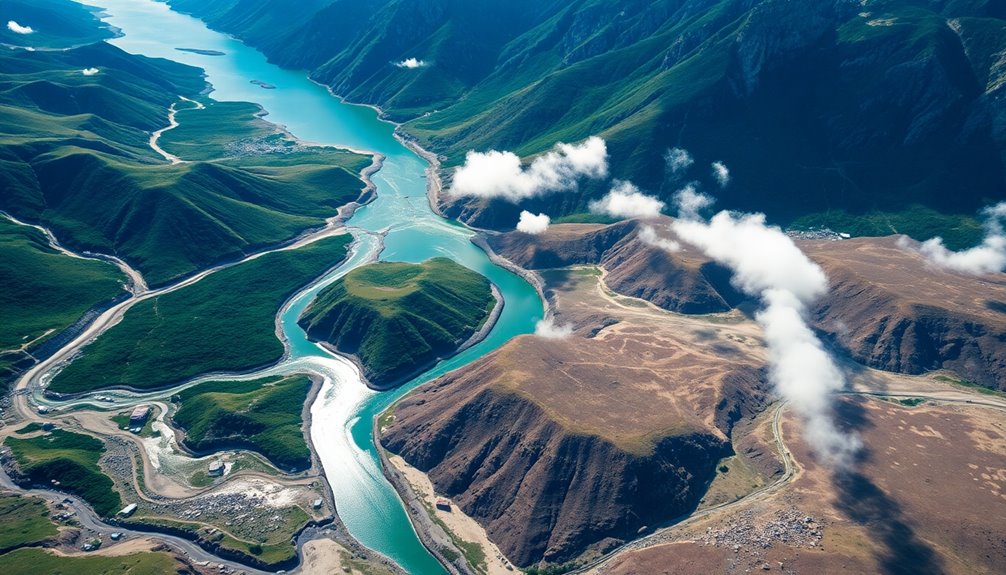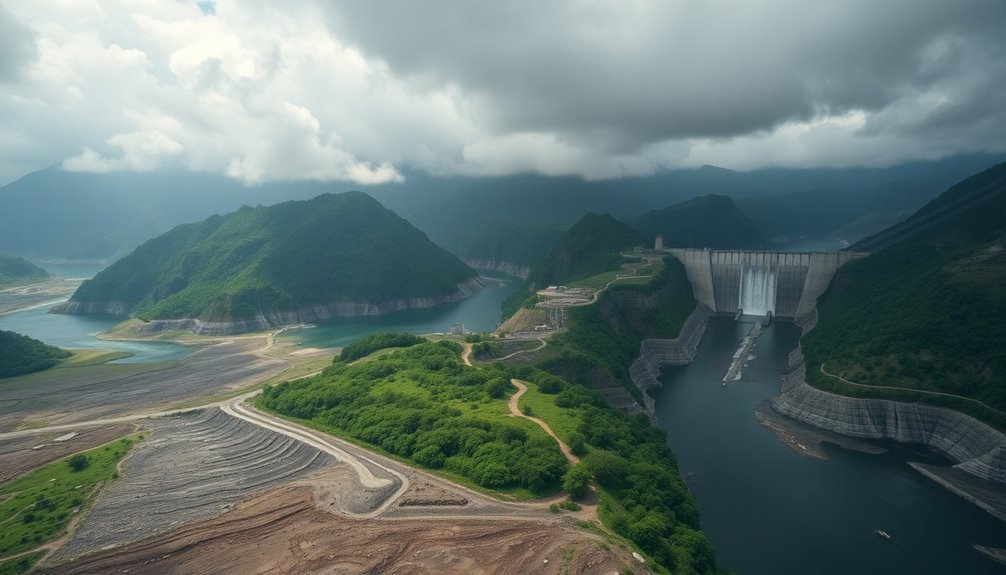Aggressive hydropower development in the Hindu-Kush Himalaya disrupts local ecosystems, leading to greenhouse gas emissions that can rival those from fossil fuels. These projects not only alter habitats but also affect sediment transport, harming agriculture and increasing methane release from decomposing vegetation. As climate change complicates water availability and reliability of hydropower, the environmental consequences can outweigh economic benefits. Discovering more about these interconnected challenges reveals vital insights into sustainable energy solutions.
Key Takeaways
- Aggressive hydropower development in the region can lead to significant greenhouse gas emissions, sometimes exceeding those of fossil fuel plants.
- Decomposing underwater vegetation in reservoirs contributes to methane and carbon dioxide emissions, impacting overall climate goals.
- Altered sediment and nutrient transport from hydropower projects negatively affect agricultural productivity, complicating local food security.
- Climate change exacerbates the reliability of hydropower generation, further complicating emissions management and energy output stability.
- Displacement of local communities due to hydropower projects can lead to long-term social challenges, outweighing economic benefits.

As you explore the impact of hydropower development on greenhouse gas emissions, it's essential to recognize that while hydropower plays a significant role in reducing global CO2 emissions—preventing about 3 gigatons annually—it also has the potential to release greenhouse gases like methane and carbon dioxide from its reservoirs.
In the Hindu-Kush Himalaya region, aggressive hydropower development poses unique challenges, as the delicate balance between energy generation and environmental impact becomes increasingly precarious.
Reservoirs created for hydropower can emit significant amounts of methane and carbon dioxide due to the decomposition of submerged vegetation. In fact, some projects in this region exhibit greenhouse gas emissions comparable to fossil fuels. This variability in emissions highlights the need for careful management of hydropower projects to avoid exacerbating climate change. Over 100 hydropower facilities have emissions greater than fossil fuel plants, underscoring the potential for significant greenhouse gas releases.
Additionally, the region is home to many plants that decompose underwater, further contributing to greenhouse gas release.
While hydropower can enhance climate resilience by providing clean energy, it's crucial to understand that it also alters natural water flows, disrupting local ecosystems and wildlife habitats. Changes in sediment and nutrient transport can negatively affect agricultural productivity downstream, impacting communities that rely on these rivers for their livelihoods.
The social implications are significant; many local populations face displacement and a loss of essential resources due to hydropower projects.
Many local communities endure displacement and resource loss as a result of hydropower initiatives.
Climate change itself adds another layer of complexity. Melting glaciers and altered monsoon patterns threaten the reliability of hydropower generation, as changes in water availability can directly impact energy output. Increased flood risks from glacial outburst floods can jeopardize hydropower infrastructure, necessitating the development of climate-resilient structures.
In the face of all these challenges, it's essential to balance the economic benefits of hydropower, such as job creation and renewable energy, with the need for effective risk management strategies to protect local communities and ecosystems.
Frequently Asked Questions
How Does Hydropower Compare to Fossil Fuels in Emissions?
When you compare hydropower to fossil fuels, you'll find that hydropower emits significantly less greenhouse gas.
It produces about 13-24 grams of CO2-equivalent per kilowatt-hour, while coal and gas emit 1,001 and 486 grams, respectively. This makes hydropower a cleaner alternative.
However, keep in mind that emissions can vary based on specific conditions, and in some cases, reservoirs can release methane, which might elevate their short-term impact.
What Are the Long-Term Ecological Effects of Dam Construction?
When you consider the long-term ecological effects of dam construction, you'll notice significant changes.
Dams disrupt natural habitats, leading to declines in aquatic biodiversity and altering sediment flows. Migratory species face challenges due to fragmented rivers.
Terrestrial ecosystems suffer from habitat loss and deforestation, risking local wildlife extinction. Additionally, altered water quality can result in eutrophication, impacting both aquatic and surrounding terrestrial environments.
The cumulative effects can be detrimental and long-lasting.
Are There Alternative Energy Sources With Lower Emissions?
Yes, there are several alternative energy sources with lower emissions you can explore.
Decentralised solar PV solutions can power agricultural operations effectively. Small-scale hydropower offers a sustainable option, while wind energy can complement solar and hydropower.
Additionally, geothermal resources and advanced biomass technologies provide efficient energy without high emissions.
How Does Local Community Displacement Impact Emissions?
Have you ever considered how displacing communities can actually increase emissions? When local populations are uprooted, they often lose sustainable practices and traditional land use, leading to higher carbon outputs.
You might find that resettlement challenges and reliance on non-renewable energy further exacerbate this issue. As displaced people adapt to new environments, their economic changes and intensified agricultural methods can also contribute to increased greenhouse gas emissions, creating a complex cycle of environmental impact.
What Policies Can Mitigate Hydropower's Greenhouse Gas Effects?
To mitigate hydropower's greenhouse gas effects, you should support policies that establish clear emissions thresholds and mandate comprehensive environmental assessments.
Encourage the integration of carbon pricing mechanisms to drive innovation and emission reductions.
Promote accurate emissions reporting for reservoirs and implement operational changes, like aeration devices to cut methane emissions.
Lastly, advocate for collaborative planning approaches that align economic, social, and environmental goals to achieve sustainable hydropower development.
Conclusion
As you consider the rapid rise of hydropower in the Hindu-Kush Himalaya, think of a dam as a double-edged sword. While it promises clean energy, it can also unleash hidden greenhouse gases trapped in the earth. For instance, a study found that tropical reservoirs can emit up to 10% of their stored carbon dioxide annually. So, while we chase renewable solutions, let's tread carefully, ensuring our quest for sustainability doesn't unintentionally worsen the climate crisis.








